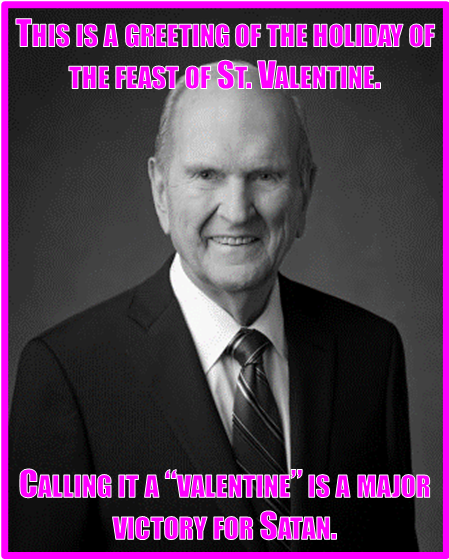I definitely did not plan on writing about abortion for my first post back. Honestly, it’s a subject I tend to avoid, largely because I feel like all the arguments on both sides have been elucidated a million times already and I don’t think I have much to add, and because conversations on the topic seem to go absolutely nowhere. But here we are, and for obvious reasons, I am feeling the need to do a bit of reflection. Read More
Happy Divine Gender Role Enforcement Day!
For Father’s Day today, my ward gave men a treat, but sacrament meeting talks weren’t focused on the importance of fathers or anything like that. This feels consistent with my experience generally. Father’s Day is mentioned at church, and sometimes talked about, but Mother’s Day by contrast is absolutely essential. It would be unthinkable to have talks about tithing or food storage on Mother’s Day, or even (at least in my experience) to have a stake conference. But Father’s Day is totally fair game to tromp on with other topics. Just to be clear, I’m absolutely not complaining about this. I’m just observing. I can buy my own treats.
The reason this happens is, I think, pretty obvious. Since it has become less acceptable to openly put women down and GAs have largely rhetorically moved from patriarchy to chicken patriarchy, they’ve needed to embrace their opportunities to pedestalize women, and explain at every turn how very very honored and equal they are. Mother’s Day is a great opportunity. Largely male speakers can rhapsodize at the pulpit about how wonderfully self-sacrificing their mothers and wives are, and how inspiring they find it that these women choose to give up their own aspirations in life to serve as supports to the men in their lives. Needless to say, there is no parallel need to reassure men about how important we are. The very structure of the Church communicates it to us constantly. Father’s Day is a nice afterthought, a reminder that oh, sure, fatherhood matters too. But it’s not doing the work that motherhood is, rhetorically, to make it seem more okay that women aren’t ordained or allowed to handle money or run wards or sacrament meetings or the highest Church councils or baptisms or funerals or excommunications. The Church embraces Mother’s Day more than Father’s Day for the same reason that we get conference talks called The Honored Place of Woman, The Moral Force of Women, LDS Women Are Incredible!, and Woman—Of Infinite Worth, but no parallel talks directed at men.
But of course it’s just my experience that a bigger deal is made at church of Mother’s Day than Father’s Day. And I’d understand if you’re a bit suspicious that I’m remembering it that way simply because I expect it to be that way. So I thought I’d do a quick look at Church magazines. I looked for references to both Mother’s Day and Father’s Day in the Ensign (this was the Google search string I used for Mother’s Day: “mother’s day” site:churchofjesuschrist.org/study/ensign). I didn’t read through each article, but I did do some quick checking to make sure the results weren’t spurious (for example, excluding those that matched only because the Table of Contents on the left of the article listed another article that had “Mother’s Day” in the title).
Here are two hypotheses I had before I gathered the data: (1) There would be more references to Mother’s Day than to Father’s Day, and (2) the number of references to Mother’s Day in particular would go up from the 1970s to the 1990s as the Church moved more toward becoming the Church of the Family Proclamation.
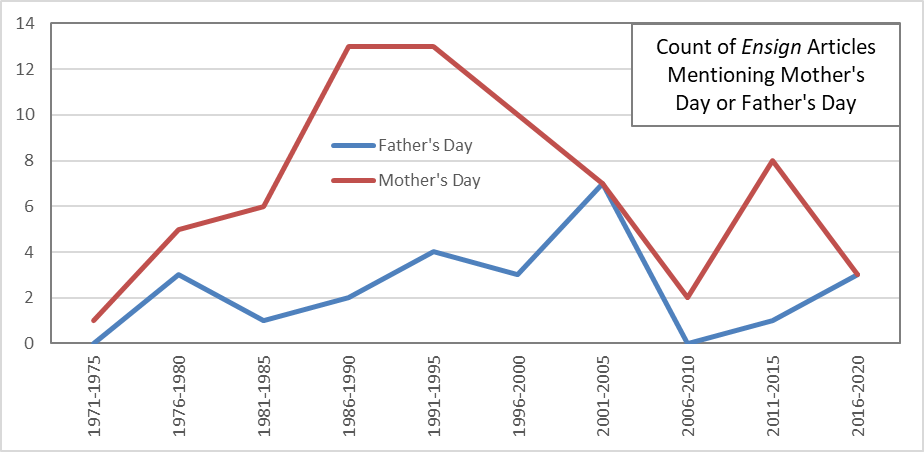
As you can see, the total number of mentions is small enough that I put it into five-year bins to make the results easier to look at. The data are surprisingly consistent with both of my hypotheses. Mother’s Day has 68 total mentions, and Father’s Day only has 24. Also, the mentions of Mother’s Day went up markedly in the 1980s and 1990s, although they’ve dropped off again since then.
Again, the number of mentions is really small. For Mother’s Day, 68 in the 50 years of the Ensign is only 1.4 mentions a year. So it’s not like discussion of these holidays is dominating Church discourse. But when one or the other does get brought up, it is, as I expected, far more often Mother’s Day.
I’d love to hear your experiences of whether Mother’s Day or Father’s Day has gotten more emphasis in wards you have lived in.
A New Lynnette? Lynnette Strikes Back? The Return of Lynnette? Regardless, I’m Back!
I didn’t actually mean to stop blogging and disappear, and leave my faithful brother Ziff to keep ZD going all alone. The last time I posted, I see, was at the very beginning of the pandemic. And then I lost my energy to say much of anything. I was in the hospital, yet again, in July of 2020, which was an unusually weird experience because of covid. If you know my history, you know that I’ve weathered a lot of depression storms, but that year I really lost my momentum, and somehow I never made it back to blogging.
However, it’s occurred to me this spring that I evidently still have a lot to say, which currently is often showing up in ridiculously long Facebook posts, and I started thinking that maybe I needed to find more outlets for that. Read More
Which Issues Do GAs Consider Unimportant?
Here’s a quote from Jeffrey R. Holland’s talk this last conference:
Of course, in our present day, tremendously difficult issues face any disciple of Jesus Christ. The leaders of this Church are giving their lives to seeking the Lord’s guidance in the resolution of these challenges. If some are not resolved to the satisfaction of everyone, perhaps they constitute part of the cross Jesus said we would have to take up in order to follow Him. [emphasis in original]
I appreciate that he (obliquely) admitted that the GAs maybe don’t have unlimited time or energy to solve all the questions of Church doctrine and policy that face them. I think it’s interesting, though, to consider what problems they do and don’t consider important enough to address. It seems quite clear that the further removed an issue is from the GAs’ personal experience, the less likely it is they’ll consider it important, and the more likely they’ll just wave it away as “well, that’s your cross to bear.”

Here are some questions that I think should obviously be pressing on GAs’ minds, but that they seem largely unconcerned about:
- How could the Church more welcoming to single people? Two speakers in April 2021 conference mentioned how many single people there are in the Church. Tellingly, M. Russell Ballard brought this issue up only after he was widowed and it became more salient to him. But is there any doctrinal innovation, or even any Church program, or even any rhetorical shift to try to help single people feel more welcome? Not that I’ve seen. It was a brief mention of the issue that appeared quickly and was gone just as fast. The Church remains a place for married people, and single people are an afterthought at best.
Gatekeeping Heavenly Mother
Recently, I was listening to an episode of the podcast “At Last She Said It” where the hosts were talking about the New Testament story of the woman with an issue of blood (for 12 years!) who was healed by touching the hem of Jesus’s robe. They made the point that the woman would have been considered ritually unclean because of her issue of blood, so it seems unlikely that she would have been able to meet with Jesus by going through any kind of official channel. So that may be why she just wedged herself through the crowd to get to him rather than trying to meet with his disciples first or something.
(Incidentally, if you enjoy podcasts and Mormon feminism, I think you should give “At Last She Said It” a try. The hosts are really interesting and insightful, and I appreciate hearing their commentary. I often hear them frame things in ways or make points that I hadn’t considered, even on topics I’ve been reading women’s commentary about online for years and years.)
Their point got me to thinking about more of the stories in the New Testament in the framework of gatekeeping or people going to great lengths to get to Jesus. For example, there was Zacchaeus, who was at first deterred by a crowd, but then climbed a tree to get Jesus’s attention, and was able to have him come to his house. The crowd was an incidental rather than an intentional obstacle, although then of course when Jesus said he was going to Zacchaeus’s house, they complained that he was hanging out with a sinning publican. Or there was the man who was let down through a roof into a house to get access to Jesus and was promptly forgiven of his sins and healed. In both of these examples, there wasn’t anyone intentionally gatekeeping access to Jesus. But in the case where people brought their children to Jesus, his disciples turned them away before Jesus famously told them to “Suffer little children . . . to come unto me.” And then there was the time a bunch of people followed Jesus into the desert to hear him preach, and his apostles wanted to send them back to their towns after a while to get food, but Jesus miraculously fed them so they could stay. Or there was the blind man who heard Jesus and his entourage were passing by and cried out for Jesus to heal him, and wasn’t deterred even when others in Jesus’s party shushed him. Jesus healed him.
What these stories have in common is that someone wants to get to Jesus for healing or blessing and someone (or something) is standing in their way, and nevertheless they persist and get to him. The person trying to get to him always appear in a good light, and the people standing in the way don’t come off so well. It’s more often that Jesus implicitly scolds the gatekeepers, like with the clamoring blind man where Jesus ignored his shushing companions and called for the man to be brought to him, but in the story with the children, he actually rebukes the gatekeepers.
I’m sure you can see where I’m going with this. Now we have lots of Church members who want to acknowledge or talk about or pray to Heavenly Mother, and the GAs are acting as gatekeepers. Dale G. Renlund last conference followed in the footsteps of Gordon B. Hinckley a few decades ago, in maybe saying things as softly as he could, but still telling members that they shouldn’t be praying to Heavenly Mother. The GAs are clearly uncomfortable with any groundswell of interest in her.

New Children of Record and Church Activity
In this post, I just want to make a small point about the Church’s report of new children of record in the annual statistical report. Here’s a graph showing annual end-of-year counts since 2010.
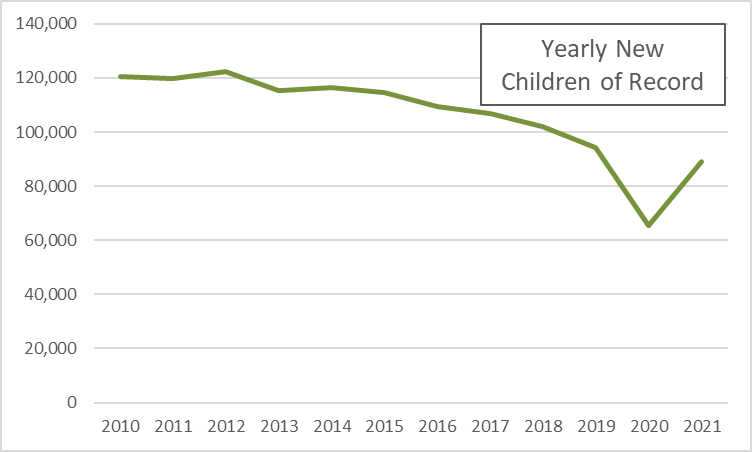
The count was flat for several years, but then started falling consistently from year to year starting in 2015. And then of course it fell off a cliff in 2020, going from 94,000 all the way to 65,000, a drop of over 30%. (For the rest of this post, I’m going to abbreviate thousands as “K,” so 94K is 94,000.)
It seems clear that the 2020 decline was caused by COVID. But there are (at least) two possible mechanisms that could be driving the effect of COVID on new children of record. One is that COVID affected birth rates. I had the idea in the back of my head that economic downturns are often associated with declining birth rates, and a quick Google turns up at least one paper that suggests that that’s true. However, given the nine month length of human gestation and the fact that COVID was officially declared a pandemic on March 11, 2020, it seems pretty unlikely that couples were changing their childbearing plans and having the effects show up before the end of the year.
The other possible mechanism by which COVID could affect children of record is through church activity. The children of record count is effectively a count of children born to or adopted by LDS families where at least one parent is active enough to get them recorded on Church records. With COVID pushing church meetings to be online, or suspended entirely, it’s not surprising that families were less diligent about recording their births and adoptions with their local units than they would have been in ordinary times. So I think the big drop from 2019 to 2020 makes sense.
What is striking, though, is that the 2020 to 2021 recovery is smaller than I would expect. New children of record rebounded from 65K to 89K, which seems like a healthy gain. But if my guess that people were just lax in recording new births and adoptions is right, there should have been a big backlog from 2020 that got recorded as people largely returned to attending church in person in 2021. Really, the 2021 count should have exceeded 2019 if this was the case.
Proselytizing vs. Service Missionary Counts in the Church Statistical Report
It may not be read in general conference anymore, but needless to say, I was interested to take a look at the Church’s 2021 statistical report. One interesting thing I noticed has to do with the counts of proselytizing versus service missionaries. Here’s a graph showing the end-of-year counts of missionaries since 2010. You can see in the count of proselytizing missionaries the jump with the age change in 2012, the slow decline afterward, and then the dramatic drop with COVID and then some recovery. The count of service missionaries has had fewer dramatic movements, increasing through 2018, then declining for a couple of years, and then increasing sharply in 2021.
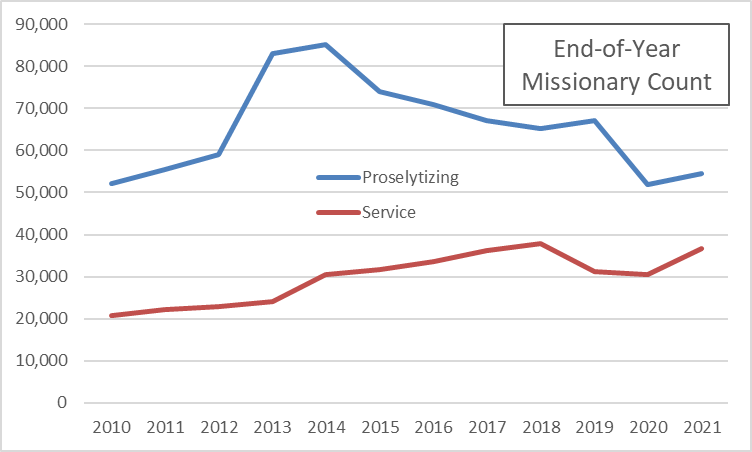
As I mentioned in my conference review post, several speakers reminded young men that they need to be serving missions, and that young women can go as well. For example, here’s President Nelson in the opening talk of the conference:
Today I reaffirm strongly that the Lord has asked every worthy, able young man to prepare for and serve a mission. For Latter-day Saint young men, missionary service is a priesthood responsibility. . . . For you young and able sisters, a mission is also a powerful, but optional, opportunity. . . . Your decision to serve a mission, whether a proselyting or a service mission, will bless you and many others. [italics in original]
As an aside, I find the patronizing tone directed toward young women grating, but I feel like at least it represents a step forward from President Hinckley’s 1997 talk where he pretty openly discouraged women from serving. Anecdotally, for some women I know who were missionaries at the time, the talk led many elders to sneer to them, “Why don’t you just go home?”
Looking back to the graph, President Nelson and the other GAs are clearly concerned with the upper line, the count of proselytizing missionaries. It fell from about 67,000 at the end of 2019 to about 52,000 at the end of 2020. Of course this can be attributed to the pandemic. But then through 2021, even as vaccines became more widely available, it rebounded only a little, to about 55,000. I suspect they’re concerned that all the disruption in missionary work because of COVID has made missionary service seem more optional.
A Heretic Reviews General Conference, April 2022
Best musical number: “Now Let Us Rejoice” Saturday afternoon. I really enjoyed this arrangement, and it gets bonus points for being so upbeat.
Worst musical number: “Our Prayer to Thee” Sunday afternoon. I’m not familiar with this hymn, but it just sounded way too soft and slow and what I think of as “Mormon reverent,” if that makes sense.
Fastest musical number: “In Hymns of Praise” Sunday afternoon. I didn’t actually check, but this seemed pretty fast to me.
Slowest musical number: “Oh, May My Soul Commune with Thee” Women’s session.
Best choir outfits: I appreciated that the women in the BYU-I choir on Saturday afternoon got to wear a very dark blue rather than a bright or pastel color that women are so often required to wear to show their adherence to divine gender roles.
Longest prayer: Vern P. Stanfill, Sunday afternoon benediction, 105 seconds. This is the second conference in a row where nobody got close to two minutes, which is kind of my rule of thumb for when a prayer starts to feel long.
Shortest prayer: Jan E. Newman, Saturday afternoon benediction, 62 seconds.
Things we don’t talk about:
- Dale G. Renlund built his whole talk around a caution to women to not try to learn more about Heavenly Mother. Or pray to her. Or speculate about her. Or ask for revelation about her. He did stop short of telling them they shouldn’t mention her, but his message was still clear.
- Gary E. Stevenson told a story of women in Poland who left strollers on a train platform for arriving Ukranian refugees who were fleeing the Russian invasion. He said “Poland,” but he couldn’t bring himself to say “Ukraine,” and certainly not “Russia.”
- Russell M. Nelson did manage to say both “Ukraine” and “Russia,” but carefully avoided naming the Russian invasion for what it is, opting instead to vaguely refer to it as “the armed conflict in eastern Europe.”
Best title: Reyna I. Aburto, “We Are The Church of Jesus Christ of Latter-day Saints”. A nice perspective, even if I think it misses the outsized control the GAs have.
Overwrought title: Patrick Kearon, “He Is Risen with Healing in His Wings: We Can Be More Than Conquerors”. I love the talk, but the title is just a bit much.
Trying too hard title: Becky Craven, “Do What Mattereth Most”.
Phoning-it-in title: Dallin H. Oaks, “Introductory Message”.
Talk that should have just been a Church Newsroom post: Dallin H. Oaks opened the Women’s session by explaining that the Saturday night session will be held going forward, but for different purposes at different times. I guess after the canceling and un-canceling of the session last year, the GAs felt like they had to come clean about the Saturday Night Session Selector (in principle, even if not in detail).
Best visual aid: Jeffrey R. Holland showed a note from a young girl who complained that conference is boring, and asked why we do it. It’s only too bad he didn’t actually discuss her question!

Conference to retain some COVID-era adaptations
This weekend, the Church will hold its first general conference to welcome a large live audience since before the COVID pandemic began. Even with the return of an audience, though, Church spokesman Heber Gordon Alonzo Pratt explains that several adaptations made during the previous four conferences will be retained going forward.
First, during the sustaining votes, which are held each conference to allow members to express their support for the First Presidency and Quorum of the Twelve and all other general-level governing bodies of the Church (as presently constituted), audience members will no longer be asked to raise their hands in support. Rather, as during the pandemic, all audience members, whether viewing online or in person, and

in real time or later using recordings, will be presumed to have expressed support unless they explicitly express otherwise by contacting their stake president and surrendering their temple recommend (if applicable). Making this change permanent has a number of benefits, Pratt explained. First, it does not privilege the voices of in-person attendees over those of members who are far from Salt Lake. Second, it eases the minds of General Authorities who may become unsettled by the possibility of a dissenting vote occurring right before their very eyes. Third, it relieves attendees, who do not know ahead of time which session the sustainings will occur in, of the burden of having to raise their hands upwards of five times. “Essentially, we’re streamlining the sustaining process by making it opt out rather than opt in,” Pratt summarized.
Name Withheld
A few years ago while reading the Ensign, I got to wondering about the reasons an article writer’s name is withheld. For an individual article, it’s typically pretty easy to guess, but I was wondering about larger trends. Even just cataloging the list of reasons seemed possibly interesting, because it’s a list of things that are considered shameful, but not too shameful. For example, a relatively large number of name withheld articles talk about divorce, but none that I’ve ever read talk about, say, bestiality. The articles provide a kind of list of troubling issues that are on writers’ (and editors’ and perhaps GAs’) minds. Also, while I was at it, I thought it would be fun to look at any trends across time and gender differences and a couple of other things.
I initially planned to look at all magazines on the Church website since 1971, but looking at the Ensign alone turned out to be fairly time-consuming, so I didn’t go any further. Maybe I’ll go back and look at the others another time. I found 172 articles and letters to the editor, using the search “‘name withheld’ site:churchofjesuschrist.org/study/ensign”. (To be precise, a few weren’t labeled exactly “name withheld.” I manually checked all the letters to the editor from the 1970s, after I found their authorship was occasionally noted as “A regular reader” or something similar.)
For each of the 172 documents, I noted the following:
- Publication year
- Gender of the writer (I was able to figure this out for 121 of the 172, or 70%)
- Is the name withheld because of something about the writer or something about another person?
- Is the person the actor (e.g., used porn) or the victim (e.g., was abused) in the situation?
- One or more reasons for the name to be withheld. (The max for any one document was four. Most documents had one. Three documents had zero, as I couldn’t figure out any reason at all.) I grouped these into 17 different categories, which I’ll list below with results.
- The story end type. I classified these into three different categories: perfect (where people end up married in the temple or going on missions), good (where things end up better than they started), and learned (where things don’t get better, but the writer learns to better accept them). I also assigned some documents a not applicable here when there was no story arc. This was the case for a fair number of the letters to the editor, where writers with name withheld often say no more than “I suffer from the same problem as the person in such-and-such an article.”
- How much the need to forgive the wrongdoer is discussed. I rated this as high, low (little discussion, or just reference to need to overcome bitterness and anger), or none.
I also tried noting down some other things, like the approximate age of the writer (typically difficult to figure out) or the location (rarely mentioned), but I wasn’t able to get enough useful data for them.
This graph shows the total number of documents in five-year periods across the history of the Ensign. Note that there’s no adjustment for possible differences in length of the magazine at different points in time.
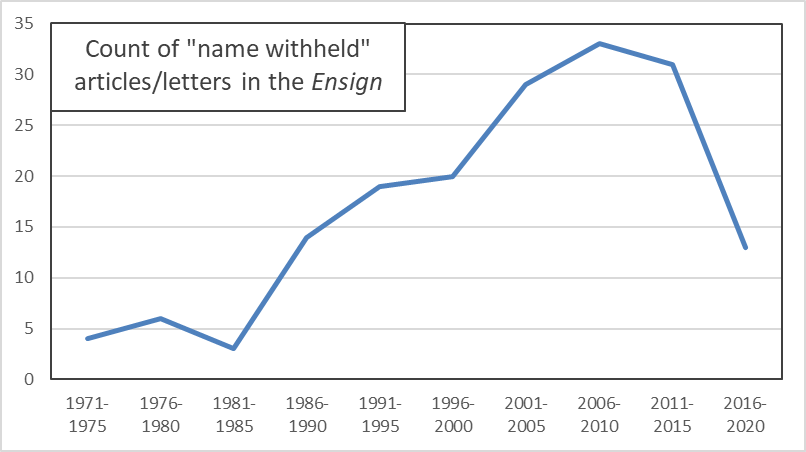
Even with my extra combing through the 1970s issues, the prevalence of “name withheld” documents really didn’t take off until the latter half of the 1980s. It’s also interesting that it has dropped so dramatically in the latter part of the 2010s. I wonder if this is a change Russell M. Nelson has made, because even the 13 in the 2016-2020 period can be broken down into six in 2016 and seven total in the four following years.
Well done, good and faithful youth leaders
All the discussion about Brad Wilcox’s awful talk recently led me to thinking, because he was addressing teens, about some of the teachers and leaders I had when I was that age. Unlike my sisters Lynnette and Kislilili, who attended Education Week religiously, and who as a result had the good fortune to hear all kinds of space doctrine from CES people like Brother Wilcox, I didn’t participate in any church activities outside our ward. In fact, I didn’t participate in many activities in our ward, for that matter. I did attend church every week, along with the rest of my family, and as a boy, I participated in passing and preparing and blessing the sacrament. But I skipped nearly all weekday activities, as they were too wrapped up in Boy Scouts, which I didn’t enjoy. All that being said, though, I’m remembering quite a few good experiences I had with leaders and teachers.

I was a difficult teenager. I was fairly bright, but I was constantly hyper-aware of my many shortcomings, and I figured that everyone else was too. As a result, I was very prickly and defensive and I’m sure not easy for my teachers and leaders to relate to. In spite of my general crabbiness at the time, I have several leaders who I remember fondly who said or did helpful things. Not all of my leaders and teachers were good, but really the majority of them were. I appreciate, especially in retrospect, thinking about what a hard kid I was, the effort they put in to making my church experience better.
- A seminary teacher once speculated in class that half of the Church would make it to the celestial kingdom. This completely blew my mind. From a young age, I had absorbed the idea that the celestial kingdom was only for people who were perfect, who kept 100% track of all their sins and repented of all of them perfectly. It was quite clear to me that the celestial kingdom was an unobtainable goal for me, probably only open to GAs and their families, so I was just hoping for the terrestrial rather than the telestial kingdom. In other ways, this teacher wasn’t particularly focused on grace or hope or anything, but this one offhand line made me think maybe I could hope for something good in the afterlife.
Conference and the Saturday Night Session Selector
With the Church’s announcement that this April’s Conference will feature a women’s session, many members have been left puzzling at the General Authorities’ rationale for handling of the Saturday night session. Last year, they first announced that the session would be discontinued, but then later brought it back as a fifth general session. All this came after the Saturday night session was for many years always a priesthood session, but was then switched in 2018 to an alternating priesthood and women’s session.
Here at ZD, we are pleased to share that we have learned the explanation for these seemingly random changes. Below is a photo leaked to us from a source deep in Church administration that appears to show President Nelson drumming up excitement before he spins the Saturday Night Selector wheel to decide what the Church will do for the upcoming Conference.

What makes an ordinance count?
I read an article recently about a Catholic priest who was found to have been saying a wrong word when he performed baptisms, and that he had been doing so since 1995. His dioceses has declared that this makes all the baptisms he performed invalid, and all subsequent rites (such as marriage) also invalid, because they are supposed to be preceded by baptism.
I’m interested in how a similar finding would play out in a Mormon context. Of course, we don’t have anyone whose job it is to baptize like a Catholic priest does. I’m guessing most child-of-record baptisms are performed by the child’s father when he’s available and a priesthood holder, and most convert baptisms are performed by male missionaries. Perhaps the closest we get would be a temple sealer, who could perform hundreds or thousands of sealings. So what would happen if it were discovered that a sealer had said a wrong word in thousands of sealings?
I think the answer hinges on whether we see ordinances as being more like magic spells, or more like parts of a relationship between us and God. If an ordinance is like a magic spell, it’s crucial that the words be said exactly right. The ordinance, spoken by someone with the proper authority, is operating on the world in the way that a chemistry experiment or a baking recipe does. The cake you’re making doesn’t care about your intent. It cares that you put the right ingredients together in the right way and bake the result at the right temperature for the right amount of time. If, on the other hand, the ordinance is part of a relationship, then the exact wording doesn’t matter so much. We’re doing it to show our commitment to God, in front of our community, and so long as both understand what our intent is, then getting the words exactly right might not be crucial.

Even More Correlated Cards for Valentine’s Day
Katie Langston’s Sealed
One good reason to read about other people’s lives is to learn about their experiences that are different from our own. But another good reason is to learn about their experiences that are the same, because it makes us feel less alone. It is for this second reason that I most enjoyed Katie Langston’s memoir Sealed: An Unexpected Journey into the Heart of Grace.
I’ve blogged before about how I grew up a neurotic Mormon. I worried about being able to keep track of all my many sins so I could properly repent of them all. I worried about impending nuclear war that some people seemed to so gleefully anticipate. But where I was neurotic, Katie (sorry I’m going to be all uncouth and call her by her first name because I know her through the Mormon feminist groups) suffered from full-on scrupulosity, although it wasn’t until she was an adult that she was able to put a name to it. She was so worried as a child that she was sinning and not remembering that she began confessing to her parents about things she was quite sure she hadn’t done, but couldn’t be 100% certain, so it seemed safer to confess and accept punishment than risk letting a sin be forgotten. She writes about how, when she turned eight and the time came to be baptized, she hoped to put it off a little, figuring that if she only got one chance to wipe her slate clean, she shouldn’t be too hasty to rush in and use it up. Unfortunately, by bringing the scheduling question up with her father, she found that she had inadvertently accelerated the process. Although I never thought of this strategy as a kid, I had so much the same line of thinking about sin.

Similarly relating her experience back to mine, where I grew up with parents who were pretty strict about church teachings, hers leaned toward fundamentalism. She was homeschooled for years, to keep her mind safe from the wickedness of secular ideas. Her parents fell into the orbit of anti-government preppers, but fortunately, when some of the most radical among them asked her parents to go with them to Mexico and become polygamists, they declined, and the experience may have pushed them toward finally sending Katie to public school.
Over and over, I so much identified with her stress about her sins. She continued to struggle with scrupulosity while on her mission in Bulgaria. Here’s a passage that I think captures her dilemma perfectly:
The Questions showed no mercy. Every day, they threatened to overtake me with despair; every night, I lay in bed, weeping silently so as to prevent my companion from hearing. I read Book of Mormon passages where characters had profound born-again experiences and felt the Spirit was their guilt away. I wanted desperately to sense something similar. What was wrong with me, that God wouldn’t grant me an experience like that? I had never, for as long as I could remember, felt whole. I’d had moments—an hour or two here, a day or two there—but always The Questions returned, driving me to the brink of what was bearable, urging me to succumb to darkness.
Nacle Notebook 2021: Funniest Comments
This post is my annual compilation of the funniest comments and bits of posts that I read on the Bloggernacle in the past year. In case you haven’t read them yet, here are links to compilations for previous years: 2020 2019 2018 2017 2016 2015 2014 2013 2012 2011 2010 2009 2008.
Most of these are excerpts from longer comments or posts. I’ve made each person’s name a link to the original source, so you can go and read them in their original context if you want. Also, the comments are in roughly chronological order.
Kirkstall, commenting on Buddhist Bishop’s post “The Holy Temple: What is Sacred is not Secret, and What is Secret is not Sacred” at W&T:
Consider the mechanical brevity of confirmations in the baptistry. The hands go on the head, the words are said, the hands come off again (Very Important). Repeat dozens of times, hundreds of times, thousands of times. Salvation by assembly line. The spirits of the long-imprisoned dead shuffle by like so many patrons of the local DMV.
Left Field, commenting on Ziff’s post “Nacle Notebook 2020: Funniest Comments” at ZD:
After eight consecutive years, I don’t make the cut!? There’s no way I lost. There’s no way. I won by hundreds of thousands of votes! I won by a lot! You had dead people voting! That’s criminal, that’s a criminal offense. And you can’t let that happen. That’s a big risk to you and Ryan, your lawyer. I had the funniest comments, by far! I just want you to find 11,780 votes for my funniest comment. There’s nothing wrong with you saying you recalculated!

Hymn Tempo in 1973 and 1985 Hymnals
This is what then-apostle Spencer W. Kimball had to say in a report of a 1955 mission tour (my source for the quote is Ardis Parshall):
Music: It is generally sung too fast.
If you’re like most Mormons I know, your complaints typically run in the opposite direction: Music is played and sung too slowly in church. This has certainly been my experience. I recall in the ward my wife and I lived in when we were first married a couple of decades ago, the hymns were so slow in sacrament meeting that I took to timing them and comparing to the suggested tempo in the hymnal and whispering complaints to my wife about how big the differences were. And that was before smartphones, so I had to do the math in my head! Along the same lines, you might notice that in my Conference review posts, I typically note particularly fast musical numbers for praise.
I was thinking about this issue while I’ve gathered some data from the hymnal in preparation for the release of the Church’s new hymnal. Like in my last post, I’m looking at the 1985 hymnal and the previous hymnal (the copy I have is from 1973, but it was largely unchanged from 1948). It occurred to me that, because many hymns appear virtually unchanged in both hymnals, I could line them up next to each other and see if the compilers of the 1985 hymnal generally suggested faster or slower tempos than the compilers of the previous hymnal did. This would be an indicator of whether they thought music was being played and sung too fast or too slowly.
For example, “The Spirit of God” appears in the 1973 hymnal with a tempo of 100 beats per minute (bpm), and in the 1985 hymnal with a tempo of 96-112 bpm. It is in 4/4 time in both hymnals, and the tune is the same. As you probably know, the 1985 hymnal always suggests a tempo range. The 1973 hymnal just suggests a single tempo, although I’m guessing it was with the expectation that there would be variation around it in practice.
I was able to find 250 matched pairs of hymns to compare across the two hymnals. I matched them on both title (taking into account that sometimes the titles changed for the same hymn) and composer, to be sure that I wasn’t comparing hymns set to different tunes. I used the 1985 hymnal as the starting point, and looked for a matching hymn for each in the 1973 hymnal. A few hymns appear more than once in the 1985 hymnal and therefore also more than once in the set of 250. For example, “Come, Come Ye Saints” is #30 in the 1985 hymnal, and also #326, for men’s voices.
This graph summarizes where the 1973 tempos fall in comparison to the 1985 tempos for the 250 matched pairs of hymns.
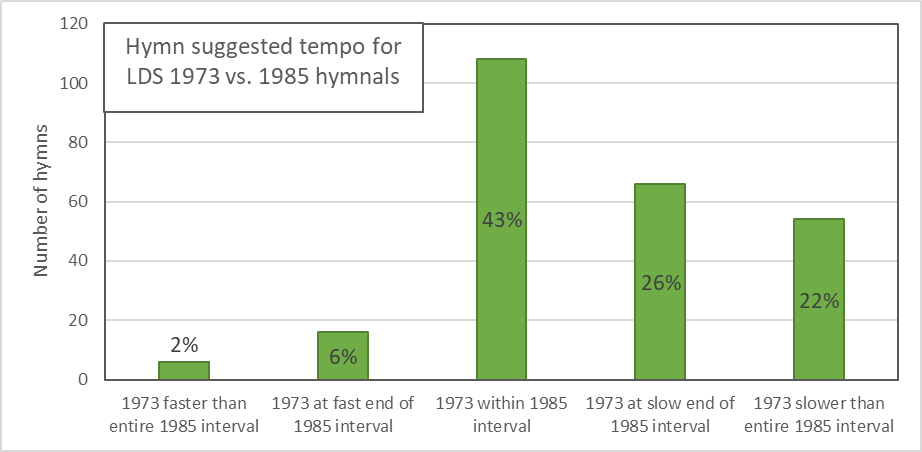
The most frequent result is that the 1973 tempo falls within the 1985 interval (the middle bar). But when it doesn’t, it’s much more common that the 1973 tempo is slower than the 1985 interval than that it’s faster. When the 1973 tempo is at the end of the interval, it’s over four times as likely (26% vs. 6%) to be at the slow end as at the fast end. When it’s entirely outside the interval, it’s over ten times as likely (22% vs. 2%) to be outside at the slow end as outside at the fast end. Another way of summarizing the same data, although it’s not shown in the graph, is that the average fraction of the 1985 tempo range that is faster than the 1973 tempo is 72%. Overall, it seems clear that the compilers of the 1985 hymnal were generally trying to speed the hymns up.
Mood of Hymns for Men vs. Hymns for Women
I’m getting ready for the Church to release the new hymnal, although I realize it will be a while still before it comes out. In preparation, I’ve been looking at some comparisons of the current 1985 hymnal with the one that preceded it. From Wikipedia, it looks like the previous hymnal was released in 1948, revised in 1950, and added to just a little in 1960. The copy I own has a copyright date of 1973, but it looks like it’s just the 1960 version (although I can tell that its preface from 1973 because it is signed by the First Presidency of Harold B. Lee, N. Eldon Tanner, and Marion G. Romney).
One difference between the two hymnals that I’ve noticed is in the hymns to be sung by men versus those to be sung by women. More particularly, the difference is in the moods used to describe how the hymns are to be sung. By “moods,” I mean the one- or two-word adverb descriptions written at the top of the hymn. For example, the current hymnbook says that hymn #1, “The Morning Breaks” is to be sung triumphantly. In the 1973 hymnal, the moods for men’s hymns aren’t too different from the moods for women’s hymns. In the 1985 hymnal, the moods for men’s versus women’s hymns are more markedly different. Because there are a lot of different mood words assigned to the hymns, I lumped them into three groups for convenience in display. Mood words like boldly I called “high energy.” Mood words like reverently I called “holy.” And mood words like peacefully I called “low energy.” Here’s a graph comparing the hymns for men and for women in the two hymnals.
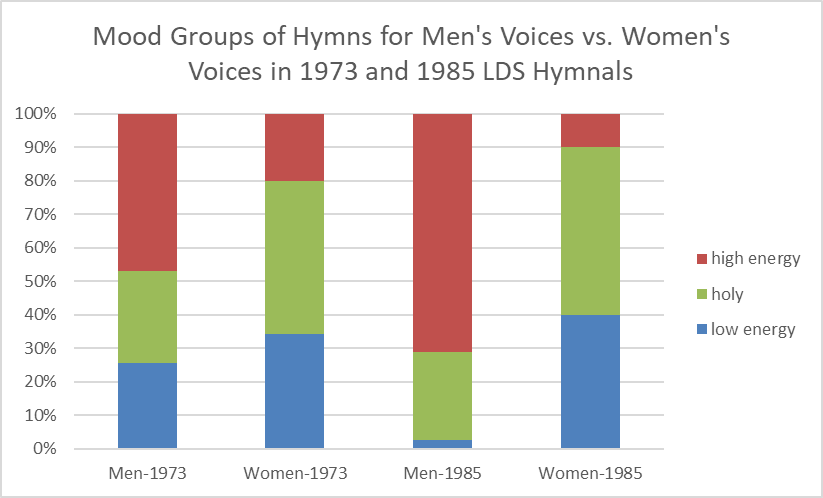
The total number of hymns specifically for men or for women was much larger in the 1973 hymnal (47 for men; 41 for women) than in the 1985 hymnal (19 for men; 10 for women). As you can see, in the graph, I’m showing percentages instead of counts to make the comparisons easier to look at. (Note that six of the 41 women’s hymns in the 1973 are excluded from the comparison because they either have no mood description, or they have a tempo word in place of a mood description.)
In the 1973 hymnal, there’s some tendency for men to be assigned more high energy moods and women more holy and low energy moods. In the 1985 hymnal, this difference gets much larger, as over two thirds of men’s hymns have high energy moods, and only 10% of women’s hymns do. This isn’t at all a surprising difference to run into. I am disappointed, though, to see that the hymn selectors’ ideas of traditional gender roles, with active men and passive, worshipful women, is translated into the hymns they select and the moods they apply to them. I hope that the new hymnal doesn’t feature such a difference, but I’m guessing that it probably will.
Bits of Conference That Might Be Harmful to Mental Health
Like I said in my review a few weeks ago, I really appreciated Erich W. Kopischke’s talk “Addressing Mental Health” this last General Conference. The motivator for him to give the talk was that his son who went on a mission suffered from anxiety, depression, panic attacks, and suicidality, and as a result, returned home after being out for four weeks. Elder Kopischke talked about the need for people who are supporting their loved ones who are facing mental health issues to learn more and to judge less:
Learning will lead to more understanding, more acceptance, more compassion, more love. It can lessen tragedy while helping us develop and manage healthy expectations and healthy interactions.
What struck me, though, thinking about his message was how many other messages in that very Conference were probably contributing to people’s mental health struggles. I realize it’s way beyond what one talk could accomplish, but there is so much preaching of perfectionism and black-and-white thinking that really needs to be toned down if GAs want to be serious about helping improve members’ mental health.

Here’s a list of some of the bits of Conference that I thought were possibly harmful to mental health. Of course, I’m no mental health expert. I’m just a run-of-the-mill neurotic Mormon, prone to depression and anxiety, so those are the types of issues I’ll focus most on. Also, note that I’m doing my church experience on the easiest setting, as a straight, white, married, cisgender man. There are plenty of messages in a typical Conference that are hard on single people, or LGBT people, or childless people, that really don’t strike me because I’m not their target. So what I’m struck by is probably a lower bound estimate for the total number of potentially harmful messages.
A Heretic Reviews General Conference, October 2021
Best musical numbers: “Come, Ye Children of the Lord”, Saturday morning; “Praise to the Lord, the Almighty”, Saturday evening
Worst musical number: “Hark, All Ye Nations”, Saturday afternoon. I appreciate when choirs sing new arrangements so we can hear new takes on old hymns, but I didn’t like this particular one.
Most up-tempo musical numbers: “Come, Rejoice” and “Sing Praise to Him”, both Sunday morning
Worst line in a musical number: “How many drops of blood were spilled for me?” from “This is the Christ”, Saturday afternoon. Please, could we not embrace making ourselves feel more guilty?
Biggest music-related surprise: Not one but two men in the BYU choir that sang Saturday evening had mustaches. (I’m just going to assume that their organist, whose face was hidden behind a mask, was also sporting a goatee.)
Longest prayer: Steven J. Lund, Saturday evening invocation, 83 seconds (This is the shortest longest prayer for a Conference I’ve found in the prayer length data I could find. The previous shortest longest was 94 seconds in April, 2019.)
Shortest prayer: Amy E. Wright, Saturday morning benediction, 54 seconds
Longest talk: Gary E. Stevenson, “Simply Beautiful—Beautifully Simple”, 1821 words
Shortest talk: Russell M. Nelson gave talks to open and close Conference that were about 550 words. No other talk was shorter than 1000 words.
Best title: Bradley R. Wilcox, “Worthiness Is Not Flawlessness”. A sermon in a sentence.
Best visual aid: Clark G. Gilbert’s photo of himself as a kid.

Your name will be assimilated into standard Conference format: Becky Craven, who’s listed under that name on the Church website, was introduced as “Rebecca L. Craven” when she was going to give a prayer in the Saturday afternoon session.
Latest member of the BYU athlete-to-GA pipeline: Vaiangina Sikahema (following Gifford Nielsen and Devin Durrant). My faith would be most strengthened if the next member were Elder James R. McMahon.
Best laugh: Bradley R. Wilcox told of a time when voice to text converted his intended message to his daughter and son-in-law “Hey, you two. Sure love you!” into “Hate you two. Should love you.”
Best labels for deity: Dieter F. Uchtdorf referred to “the gentle Christ,” “our bountiful and forgiving God,” and the “God of new beginnings.” Camille N. Johnson called Jesus “the Master Author.”
Best stories:
- Sharon Eubank told about some German LDS women who discovered that women among Afghan refugees who had arrived near them had lost their head coverings. The LDS women then sewed head coverings for the Afghan women. I love this story because the women helped the refugees, and in particular because they helped them in a way that showed them taking the recipients’ religion seriously.
- Dale G. Renlund told of how when a temple was built in Finland, the temple committee, made up entirely of Finns, decided to allow visiting Russians to perform the first ordinances in the temple, in spite of the fact that the Russians and Finns have historically been enemies. He concluded, “The Finns were no less Finnish; the Russians were no less Russian; neither group abandoned their culture, history, or experiences to banish enmity. They did not need to. Instead, they chose to make their discipleship of Jesus Christ their primary consideration.”
- Brent H. Nielson told the story of how his family rallied around his father when he was diagnosed with pancreatic cancer, but in the end, he died in just a few months. I appreciated how this story lacked a Correlated ending, with a miraculous healing and doctors and nurses converted to boot.
